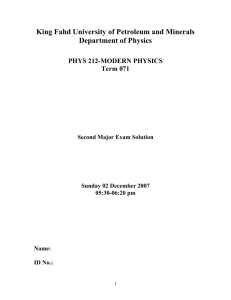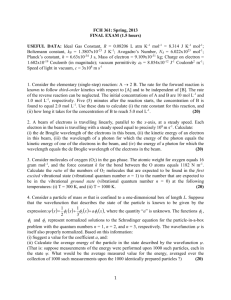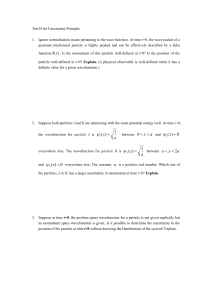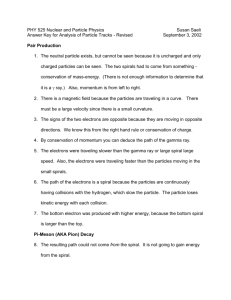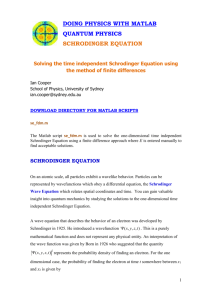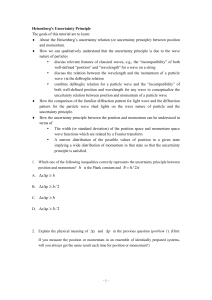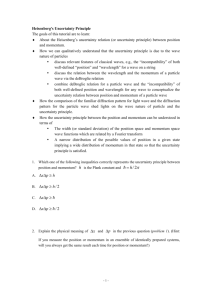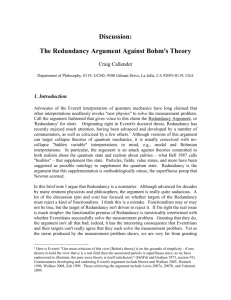Exam #2 from 2010
advertisement
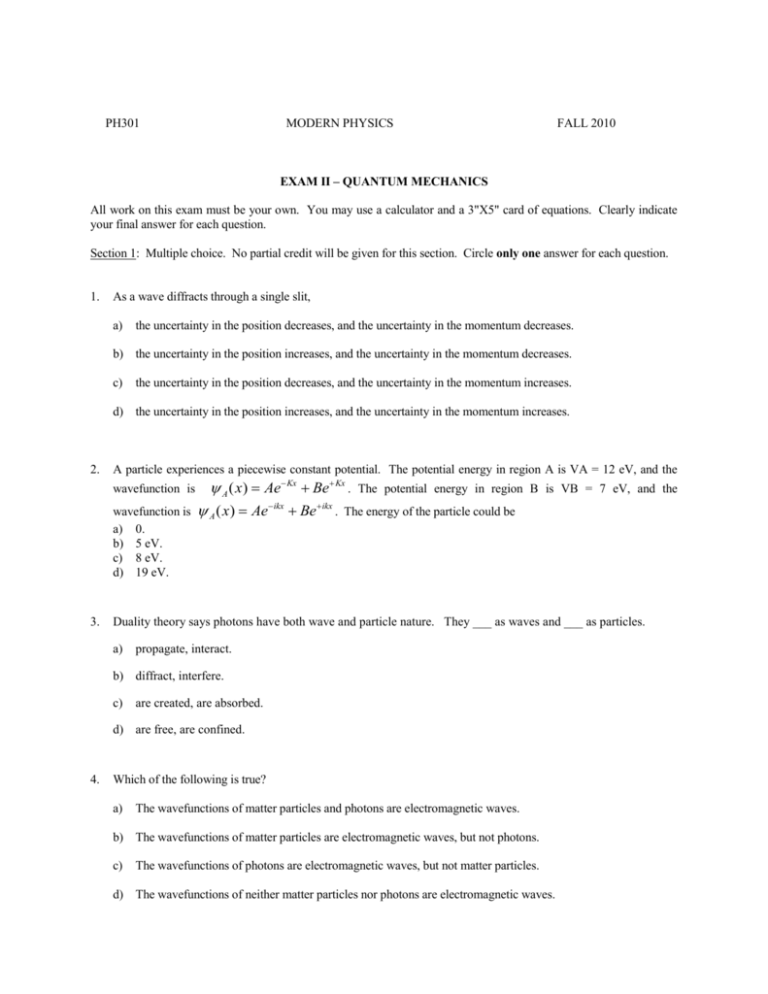
PH301 MODERN PHYSICS FALL 2010 EXAM II – QUANTUM MECHANICS All work on this exam must be your own. You may use a calculator and a 3"X5" card of equations. Clearly indicate your final answer for each question. Section 1: Multiple choice. No partial credit will be given for this section. Circle only one answer for each question. 1. As a wave diffracts through a single slit, a) the uncertainty in the position decreases, and the uncertainty in the momentum decreases. b) the uncertainty in the position increases, and the uncertainty in the momentum decreases. c) the uncertainty in the position decreases, and the uncertainty in the momentum increases. d) the uncertainty in the position increases, and the uncertainty in the momentum increases. 2. A particle experiences a piecewise constant potential. The potential energy in region A is VA = 12 eV, and the wavefunction is wavefunction is a) 0. b) 5 eV. c) 8 eV. d) 19 eV. 3. A ( x) Ae Kx Be Kx . A ( x) Ae ikx Be ikx The potential energy in region B is VB = 7 eV, and the . The energy of the particle could be Duality theory says photons have both wave and particle nature. They ___ as waves and ___ as particles. a) propagate, interact. b) diffract, interfere. c) are created, are absorbed. d) are free, are confined. 4. Which of the following is true? a) The wavefunctions of matter particles and photons are electromagnetic waves. b) The wavefunctions of matter particles are electromagnetic waves, but not photons. c) The wavefunctions of photons are electromagnetic waves, but not matter particles. d) The wavefunctions of neither matter particles nor photons are electromagnetic waves. 5. Which of the following is not a consequence of the uncertainty principle? a) Zero-point motion, i.e. the non-zero kinetic energy of atoms no matter how cold they are. b) Uncertainty in a unstable particle’s mass. c) The energy of short-lived particles cannot be measured with arbitrary accuracy. d) The momentum of a particle cannot be measured with arbitrary accuracy. 6. The wavefunction of a particle is (x). Which of the following expressions will give you the expectation value of the position of the particle? (x) . d b) . dx 2 c) | ( x) | . a) d) x | ( x) | 2 dx . 7. Which of the following is not true of all stationary states? a) The average momentum is zero b) The uncertainty in the energy is zero. c) The expectation value of position is constant. d) The probability density changes with time according to e-Eit/. 8. Assume that a hot engine approximates a blackbody. One can find the wavelength of peak radiation emitted by a hot engine at a temp of about 300oF (about 420K). The peak of its emission spectrum will be a) infrared b) visible light c) ultraviolet d) cannot be determined from the given information 9. An electron and a proton have the same speed. The electron’s momentum is ______ the proton’s, and its wavelength is ______ the proton’s. a) less than, greater than. b) less than, less than. c) less than, equal to. d) equal to, equal to. 10. A proton is in a stationary state of a one-dimensional box (infinite square well potential). Is the first derivative of its wavefunction with respect to x (d/dx)a continuous function? a) yes, because it is a requirement for all wavefunctions b) yes, but it is not a requirement for all wavefunctions c) no d) the answer depends on which state it is in (depends on the value of n) Section 2: Problems and questions. Partial credit will be given for this section. Show all work and justify all answers. “Set up, but do not solve” solutions should have no undefined constants or variables. 11. (16 pts) Light of wavelength 500 nm will eject electrons from a particular metal giving them kinetic energies up to 0.1 eV. a) Find the work function of the metal. b) Will blue or red light cause the photoelectric effect in this metal? Justify. 12. (16 pts) An unstable state has an energy of 3.000eV+ 0.001eV. The uncertainty here is mostly due to the wave nature of the state, not to limitations of measuring equipment. a) Find the lifetime of the state. b) Find the wavelength and uncertainty in wavelength of light emitted as the state decays to a stable state at 0.2 eV (report your answer as+). 13. (16 pts) A particle with mass, m=1, is subjected to a potential energy function, V(x) = 32x2 for all x. It’s wavefunction is given by ( x) Ae4 x 2 / for all x. a) Use the time-independent Schroedinger equation to show that this wavefunction is indeed a stationary state wavefunction. b) What is the energy of this particle (leave the answer in terms of )? 14. (16 pts) Refer to the wavefunction of #13. a) Set up, but do not solve, an equation that would determine the value of A. b) State in words the physical reason why this equation (your answer to part a) must be true. c) Set up, but do not solve, an expression for the probability that the electron will be found between x=0 and x=7. 15. (16 pts) A proton is in a one-dimensional box (infinite square well potential) of length 0.015 nm. a) Find the energy of the ground state (lowest energy level) as well as the 3 rd excited state (i.e. the 3rd state above the ground state or n=4). b) For which of these states is the proton most likely to be found near the center of the box? Justify. c) Explain the physical reason why the wavefunction for a particle in a box must have an integer number of ½-wavelengths within the length of the box. 16. Extra Credit (5 pts): A proton in a one-dimensional box (infinite square well potential) is in a state that does not have definite energy, but rather it is a superposition (combination) of energies E a=2 eV and Eb=8 eV. The expectation value of the energy is <E> = 4 eV. a) Find the probability that the particle will be found to have an energy of 4 eV. b) Find the probability that the particle will be found to have an energy of 2 eV. c) Write down a possibility for the proton’s full time-dependent wavefunction, using no undefined constants or variables, except x and t. Some info you may or may not need: electron mass = 9.11 X 10-31 kg = 5.49 X 10-4 u = 0.511 MeV/c2 mass of proton = 938 MeV/c2 = 1.67X10-27 kg 1 MeV = 106 eV 1 eV = 1.6X10-19 J 1 nm = 10-9 m speed of light c = 2.998 X 108 m/s Combo hc = 1240 eVnm Combo c = 197 eVnm Gravitational constant G=6.67 X 10-11 Nm2/kg2 Planck's constant h =6.626 X 10-34 Js = 4.136 X 10-15 eVs, his other constant =1.054 X 10-34 Js =6.582 X 10-16 eVs
